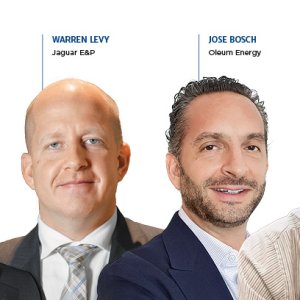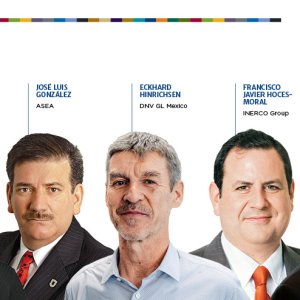
International Practices in Deepwater
Moderator: Chris García, Mexico International Account Director and Deepwater Adviser of Schlumberger Oilfield Services
Panelist: James Buis, District Manager Mexico of Nalco Champion
Panelist: Bill Heiam, NSAM Sales Director of OneSubsea
Panelist: Oscar López Velarde, Partner, Mexico Oil & Gas Tax Leader at Ernst & Young
The moderator, Chris García, explained some basic elements of deepwaters, mentioning activity in the US side of the Gulf to highlight the importance of this segment. He did point out that one in ten wells in Perdido results in a commercial success, so the investment risk is high. However, the US side has 70% success rates. Furthermore, a deepwater project creates close to 30 inland jobs to support operations in the rig. He proceeded to ask how Mexican deepwaters compare to those of countries like the US, Angola, and Brazil.
James Buis answered that the main element is infrastructure. “Things in Mexico will have to be built from the ground up to address challenges such as flow assurance.” He said his company, Nalco Champion, likes to be involved at the early stages of a deepwater project because it enables his firm to anticipate challenges, increasing the success rates. “Nalco Champion provides solutions for asphaltenes and paraffins, ensuring a quality output. Chemicals have to be designed and selected with the movement of the fluid in mind.”
López Velarde spoke about the differences in the bidding processes between Mexico, Brazil and the US, saying that the US has a more mature deepwater segment with fixed royalties. He mentioned that Mexico still does not have fiscal terms for deepwaters, and companies have shown a preference for licenses over profit-sharing agreements. López Velarde then spoke about the environment in Brazil, which has more uncertainty regarding fiscal and regulatory matters, but these are mitigated with the contract models. In addition to signature bonuses, local content requirements are crucial in Brazil. “In Mexico the main challenges will be to find a way to account for or measure local content. All the equipment required for the projects is not manufactured in Mexico, so complying with a simple 13% will be difficult,” he stressed. García added that in order to comply with local content rules, companies need to comply with certain experience requirements.
Heiam said that given the small differences between the US and Mexican side of Perdido, Mexico is likely to have attractive resources and now there is a framework to do so in place. García pointed out that a significant difference between Perdido and Brazil and Angola is that the latter do not have hurricanes, thus they can rely on FPSOs. Also, the US side of Perdido deals with sandstone basins, Brazil with pre-salt basins, and Angola has small reservoirs, making the use of FPSOs rather useful. Mexico should learn the lessons from the area it will work on, so it should look at the US, not Brazil. In addition, wells in Perdido have a lower recovery and flow rate than wells in Macondo because these two belong to different geological formations. “Perdido is one of the extreme deepwater areas in the world. Given the challenging depths and conditions, what innovative technologies are available today, and which will play a crucial role in the development of Mexico’s deepwater market?”
Heiman commented that Lakach has a water depth of 1,000m and is a gas reservoir. However, wells in Perdido have crude, which means a different well pressure level, and water depths of 3,000m. “Deepwater projects in Perdido have reservoir pressures that cannot handle flows of 3,000m. OneSubsea has a boosting pump for the seafloor that will be necessary from day one for any well in the Mexican side of Perdido. Boosting systems will be critical in Mexico.”
García stirred up some controversy by asking what would be the consequences, particularly in terms of local content rules, of using US infrastructure to accelerate production in Mexico. López Velarde said Mexico lacks infrastructure, so it makes sense from an economic perspective to use infrastructure in the US. “After all, most oil produced in Mexico will touch Houston at some point. However, the key word is ‘regulation’. If we do not work on regulation for sharing infrastructure, we will probably have a painful learning curve.”














